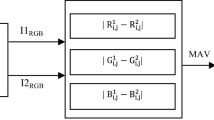Abstract
Image quality assessment algorithms aim to evaluate the perceptual quality of an image by assigning an evaluation score. By comparing the scores, the perceptual similarity or difference between two images can be assessed. In this paper, we present a new full-reference image quality metric method which was developed by combining Sobel magnitude and chrominance information in the YIQ color space. But differing from existing methods, our model incorporates color intensity adaptation to extract and enhance perceptually significant image features. The proposed metrics are tested on three well-known databases available in the literature (TID2013, TID2008, and CSIQ). Experimental results presented to confirm that the proposed metric is an effective and have low computational complexity.



Similar content being viewed by others
References
I.T.U-R Rec. BT.500-11, Methodology for the subjective assessment of the quality of television pictures. (International Telecommunication Union, Geneva, 2002)
Wang, Z., Bovik, A.C., Lu, L.: Why is image quality assessment so difficult? In: Acoustics, Speech, and Signal Processing (ICASSP), 2002 IEEE International Conference on, vol. 4, pp. IV-3313. IEEE (2002)
Girod, B.: What’s wrong with mean-squared error? In Digital images and human vision, pp. 207–220. MIT Press (1993)
He, L., Gao, F., Hou, W., Hao, L.: Objective image quality assessment: a survey. Int. J. Comput. Math. 91(11), 2374–2388 (2014)
Wang, Z., Bovik, A.C., Sheikh, H.R., Simoncelli, E.P.: Image quality assessment: from error visibility to structural similarity. IEEE Trans. Image Process. 13(4), 600–612 (2004)
Zhang, L., Zhang, L., Mou, X., Zhang, D.: FSIM: a feature similarity index for image quality assessment. IEEE Trans. Image Process. 20(8), 2378–2386 (2011)
Xue, W., Zhang, L., Mou, X., Bovik, A.C.: Gradient magnitude similarity deviation: a highly efficient perceptual image quality index. IEEE Trans. Image Process. 23(2), 684–695 (2014)
Chandler, D.M., Alam, M.M., Phan, T.D.: Seven challenges for image quality research. In: IS&T/SPIE Electronic Imaging, pp. 901402–901402. International Society for Optics and Photonics (2014)
Zhang, L., Zhang, L., Mou, X., Zhang, D.: A comprehensive evaluation of full reference image quality assessment algorithms. In: Image Processing (ICIP), 2012 19th IEEE International Conference on, pp. 1477–1480. IEEE (2012)
Yang, C.C., Kwok, S.H.: Efficient gamut clipping for color image processing using LHS and YIQ. Opt. Eng. 42(3), 701–711 (2003)
Nafchi, H.Z., Hedjam, R., Shahkolaei, A., Cheriet, M.: Deviation Based Pooling Strategies for Full Reference Image Quality Assessment. arXiv preprint arXiv: 1504.06786 (2015)
Liu, A., Lin, W., Narwaria, M.: Image quality assessment based on gradient similarity. IEEE Trans. Image Process. 21(4), 1500–1512 (2012)
Gore, A., Gupta, S.: Full reference image quality metrics for JPEG compressed images. AEU Int. J. Electron. Commun. 69(2), 604–608 (2015)
Rohaly, A.M., Corriveau, P.J., Libert, J.M., Webster, A.A., Baroncini, V., Beerends, J., Jean-Louis B., et al.: Video quality experts group: current results and future directions. In: Visual Communications and Image Processing 2000, pp. 742–753. International Society for Optics and Photonics (2000)
Sheikh, H.R., Bovik, A.C.: Image information and visual quality. IEEE Trans. Image Process. 15(2), 430–444 (2006)
Larson, E.C., Chandler, D.M.: Most apparent distortion: full-reference image quality assessment and the role of strategy. J. Electron. Imaging 19(1), 011006–011006 (2010)
Sheikh, H.R., Bovik, A.C., De Veciana, G.: An information fidelity criterion for image quality assessment using natural scene statistics. IEEE Trans. Image Process. 14(12), 2117–2128 (2005)
Ponomarenko, N., Ieremeiev, O., Lukin, V., Egiazarian, K., Jin, L., Astola, J., Vozel B., et al. Color image database TID2013: peculiarities and preliminary results. In: Visual Information Processing (EUVIP), 2013 4th European Workshop on, pp. 106–111. IEEE (2013)
Ponomarenko, Nikolay, Lukin, Vladimir, Zelensky, Alexander, Egiazarian, Karen, Carli, M., Battisti, F.: TID2008—a database for evaluation of full-reference visual quality assessment metrics. Adv. Mod. Radioelectron. 10(4), 30–45 (2009)
Author information
Authors and Affiliations
Corresponding author
Rights and permissions
About this article
Cite this article
Gupta, S., Gore, A., Kumar, S. et al. Objective color image quality assessment based on Sobel magnitude. SIViP 11, 123–128 (2017). https://doi.org/10.1007/s11760-016-0910-9
Received:
Revised:
Accepted:
Published:
Issue Date:
DOI: https://doi.org/10.1007/s11760-016-0910-9




